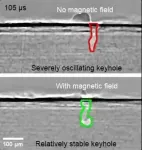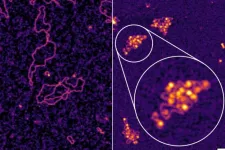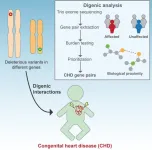(Press-News.org) High-performance computing (HPC) systems – advanced computing ensembles that harness deliver massive processing power – are used for a range of applications, and the demand for them has increased with the rise of generative artificial intelligence (AI). However, for both traditional uses and to advance the power of AI, technical advances in HPC are greatly needed, say Ewa Deelman and colleagues in a Policy Forum. “With international competition for leadership in computing intensifying, without a renewed commitment, we fear that the US will soon lose scientific computing leadership and technological independence,” say the authors. They outline how HPC systems are in a state of transition, shaped by both technology constraints and market forces. Among the major challenges for HPC systems are the wide use of chips with lower-precision arithmetic – insufficient for applications important for science, engineering, and defense – as well as the power consumption of current machines. Deelman and colleagues highlight how over time, the global HPC landscape has evolved, placing HPC in a geopolitical arena where nations compete for technological sovereignty. They provide examples of HPC-related initiatives in different nations, which “reveal deep-seated policy and technical tensions around national security, international collaboration, and market independence.” The authors write, “With this Policy Forum, we aim to bring attention to the totality of challenges and opportunities in HPC and advocate for a multiagency, ‘whole-nation,’ and internationally collaborative effort to reenergize HPC R&D.”
END
High-performance computing at a crossroads
Summary author: Meagan Phelan
2025-02-20
ELSE PRESS RELEASES FROM THIS DATE:
Chemists find greener path to making key industrial chemical
2025-02-20
Scientists have discovered a potentially greener way to produce a crucial industrial chemical used to make many everyday products from plastics and textiles to antifreeze and disinfectants, according to a new study published in Science and co-authored by Tulane University chemical engineer Matthew Montemore.
The breakthrough could significantly reduce greenhouse gas emissions from the manufacture of ethylene oxide, which has an estimated $40 billion global market. The current production process requires chlorine, which is toxic and ...
Giant X-ray facility shows that magnets can reduce flaws in 3D printed components
2025-02-20
Safety critical components for aircraft and Formula 1 racing cars could one day be 3D printed via a new technique, developed by researchers at UCL and the University of Greenwich, that substantially reduces imperfections in the manufacturing process.
The technique was developed after the team used advanced X-ray imaging to observe the causes of imperfections that formed in complex 3D printed metal alloy components. If this technique becomes widely deployed it could make a range of these components, from artificial hip joints to aircraft parts, stronger and more durable.
The study, published in Science, observes the forces at play during ...
Cooling materials – Out of the 3D printer
2025-02-20
Rapid, localized heat management is essential for electronic devices and could have applications ranging from wearable materials to burn treatment. While so-called thermoelectric materials convert temperature differences to electrical voltage and vice versa, their efficiency is often limited, and their production is costly and wasteful. In a new paper published in Science, researchers from the Institute of Science and Technology Austria (ISTA) used a 3D printing technique to fabricate high-performance thermoelectric materials, reducing production costs significantly.
Thermoelectric coolers, also called solid-state ...
New knowledge portal adiposetissue.org enhances obesity and metabolism research with centralized data
2025-02-20
Addressing the Challenge of Dispersed Data
For years, adipose tissue research has generated vast amounts of omics data, but these datasets remained scattered across different repositories, making comprehensive analysis challenging. Adiposetissue.org now brings insights together, integrating transcriptomic and proteomic with clinical data from more than 6,000 individuals, enabling researchers to explore obesity-related changes, weight-loss effects, and cellular mechanisms with unprecedented depth.
“We developed ...
Study suggests new molecular strategy for treating fragile X syndrome
2025-02-20
Building on more than two decades of research, a study by MIT neuroscientists at The Picower Institute for Learning and Memory reports a new way to treat pathology and symptoms of fragile X syndrome, the most common genetically-caused autism spectrum disorder. The team showed that augmenting a novel type of neurotransmitter signaling reduced hallmarks of fragile X in mouse models of the disorder.
The new approach described in Cell Reports works by targeting a specific molecular subunit of “NMDA” receptors that they discovered plays a key role in how neurons synthesize ...
Digging into a decades-old hepatitis B mystery suggests a new potential treatment
2025-02-20
In their effort to answer a decades-old biological question about how the hepatitis B virus (HBV) is able to establish infection of liver cells, research led by Memorial Sloan Kettering Cancer Center (MSK), Weill Cornell Medicine, and The Rockefeller University identified a vulnerability that opens the door to new treatments.
The team successfully disrupted the virus’s ability to infect human liver cells in the laboratory using a compound already in clinical trials against cancer — laying the ...
Big birds like emus are technical innovators, according to University of Bristol researchers
2025-02-20
Large birds – our closest relations to dinosaurs - are capable of technical innovation, by solving a physical task to gain access to food.
This is the first time scientists have been able to show that palaeognath birds such as emus and rheas can solve tricky problems.
In the study, published today in Scientific Reports, emus, which have previously been called the ‘world’s dumbest bird’ were able to create one new technique to access food (lining up a hole with a food chamber) and moved the hole in the most efficient direction towards food in 90% of cases. A male rhea ...
Hidden genetic causes of congenital heart disease identified
2025-02-20
New York, NY [February 20, 2025]—Scientists at the Icahn School of Medicine at Mount Sinai and collaborators have identified novel genetic interactions that may contribute to congenital heart disease (CHD), a common birth defect. Details on their findings were reported in the February 20 online issue of The American Journal of Human Genetics [DOI: 10.1016/j.ajhg.2025.01.024].
“Our research reveals the potential for digenic inheritance—where two genes work together to cause disease—expanding our understanding of the genetic underpinnings of congenital heart ...
Semaglutide and nonarteritic anterior ischemic optic neuropathy
2025-02-20
About The Study: The results of this study suggest a modest increase in the risk of nonarteritic anterior ischemic optic neuropathy among individuals with type 2 diabetes associated with semaglutide use, smaller than that previously reported, and warranting further investigation into the clinical implications of this association.
Corresponding Author: To contact the corresponding author, Cindy X. Cai, MD, MS, email ccai6@jhmi.edu.
To access the embargoed study: Visit our For The Media website at this link https://media.jamanetwork.com/
(doi:10.1001/jamaophthalmol.2024.6555)
Editor’s ...
Inequities in the application of behavioral flags for hospitalized pediatric patients
2025-02-20
About The Study: This cohort study found significant inequities in incidence of behavioral flags in the electronic health record among racially and socioeconomically marginalized pediatric patients. This finding was most pronounced for Black or African American patients younger than 8 years, suggesting that this phenomenon may be a response to Black families rather than specific patient behavior.
Corresponding Author: To contact the corresponding author, April Edwell, MD, MAEd, email April.edwell@ucsf.edu.
To access the embargoed study: Visit our For The Media website at this link https://media.jamanetwork.com/
(doi:10.1001/jamanetworkopen.2024.61079)
Editor’s ...
LAST 30 PRESS RELEASES:
University of Oklahoma researcher awarded funding to pursue AI-powered material design
Exploring how the visual system recovers following injury
Support for parents with infants at pediatric check-ups leads to better reading and math skills in elementary school
Kids’ behavioral health is a growing share of family health costs
Day & night: Cancer disrupts the brain’s natural rhythm
COVID-19 vaccination significantly reduces risk to pregnant women and baby
The role of vaccination in maternal and perinatal outcomes associated with COVID-19 in pregnancy
Mayo Clinic smartwatch system helps parents shorten and defuse children's severe tantrums early
Behavioral health spending spikes to 40% of all children’s health expenditures, nearly doubling in a decade
Digital cognitive behavioral treatment for generalized anxiety disorder
Expenditures for pediatric behavioral health care over time and estimated family financial burden
Air conditioning in nursing homes and mortality during extreme heat
The Alps to lose a record number of glaciers in the next decade
What makes a good proton conductor?
New science reporting guide published for journalists in Bulgaria
New international study reveals major survival gaps among children with cancer
New science reporting guide published for journalists in Turkey
Scientists develop a smarter mRNA therapy that knows which cells to target
Neuroanatomy-informed brain–machine hybrid intelligence for robust acoustic target detection
Eight SwRI hydrogen projects funded by ENERGYWERX
The Lundquist Institute and its start-up company Vitalex Biosciences Announces Strategic Advancement of Second-Generation fungal Vaccine VXV-01 through Phase 1 Trials under $40 Million Competitive Con
Fine particles in pollution are associated with early signs of autoimmune disease
Review article | Towards a Global Ground-Based Earth Observatory (GGBEO): Leveraging existing systems and networks
Penn and UMich create world’s smallest programmable, autonomous robots
Cleveland researchers launch first major study to address ‘hidden performance killer’ in athletes
To connect across politics, try saying what you oppose
Modulating key interaction prevents virus from entering cells
Project explores barriers to NHS career progression facing international medical graduates
Jeonbuk National University researchers explore the impact of different seasonings on the flavor perception of Doenjang soup
Two Keck Medicine of USC Hospitals named Leapfrog Top Teaching Hospitals
[Press-News.org] High-performance computing at a crossroadsSummary author: Meagan Phelan





